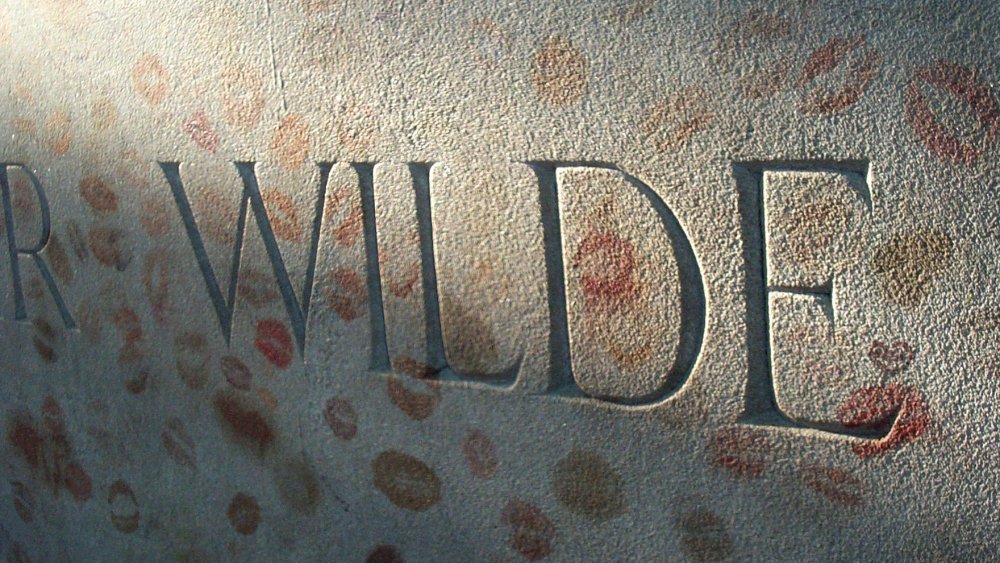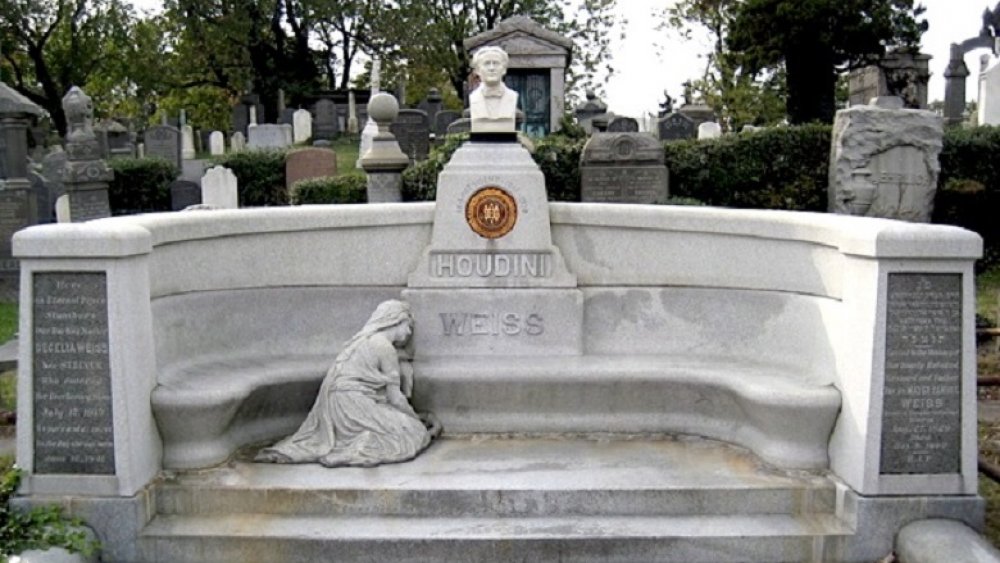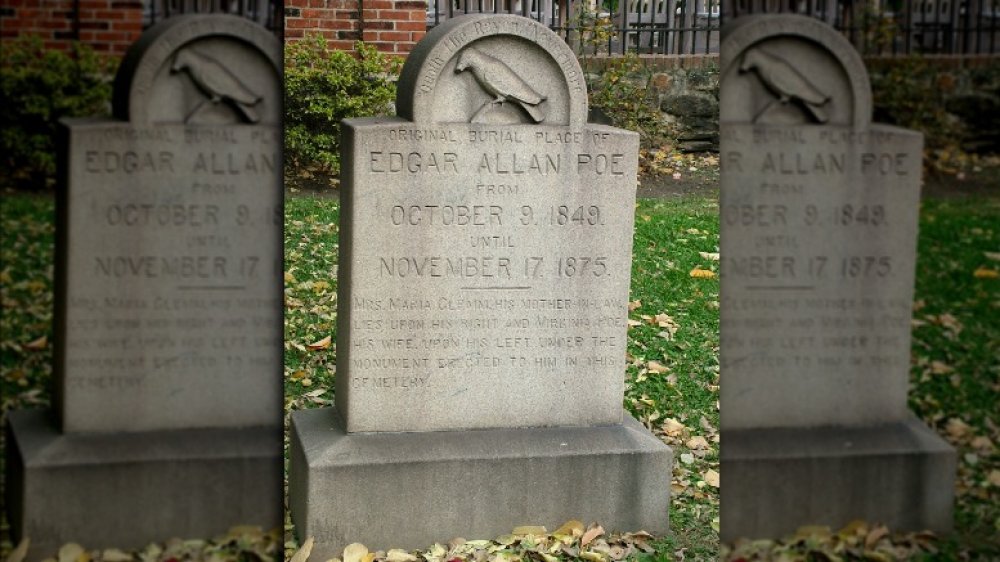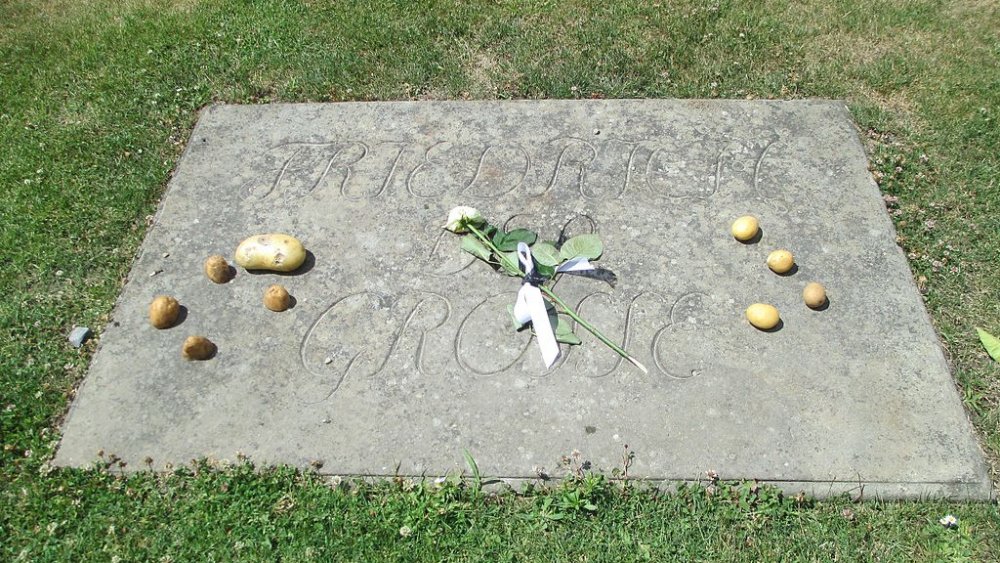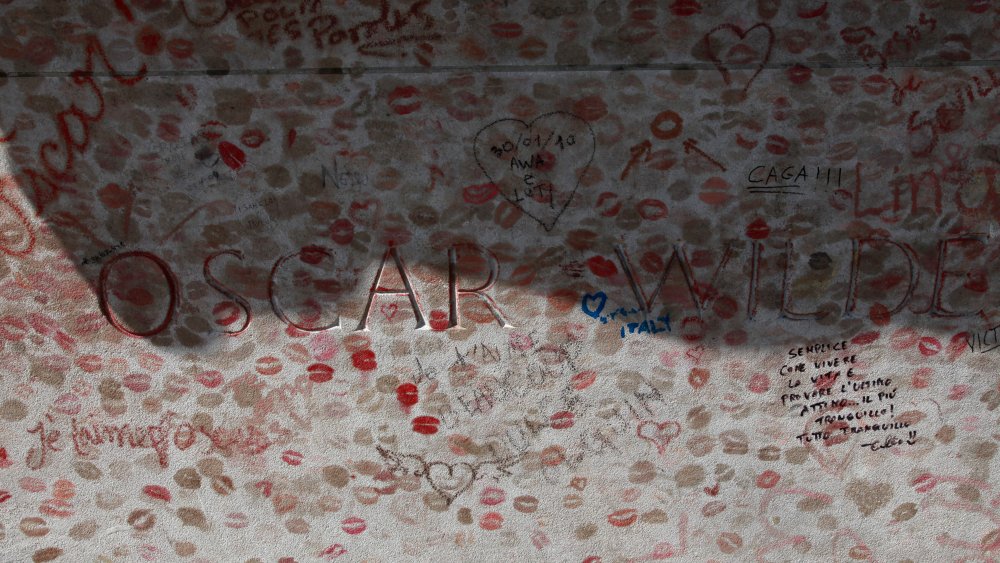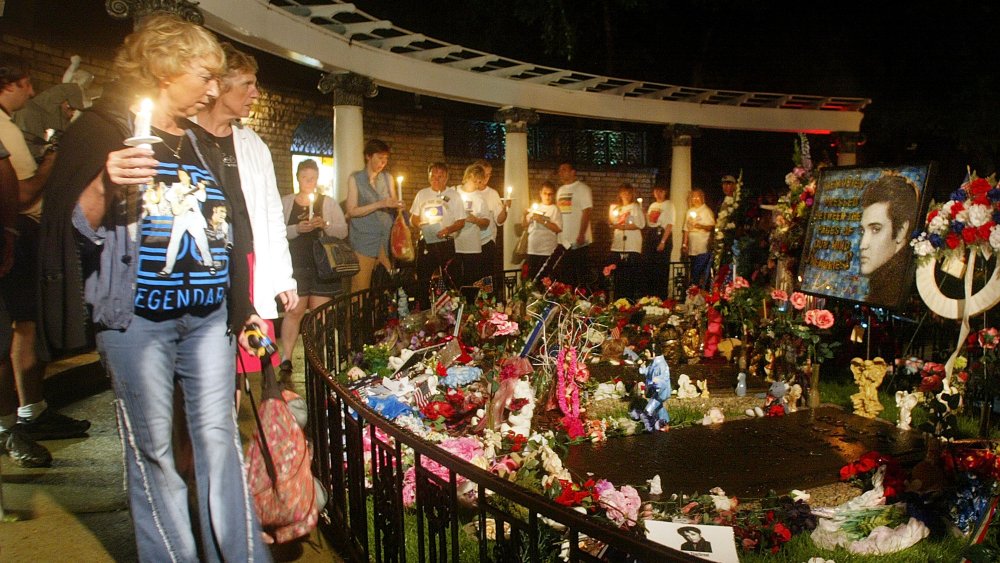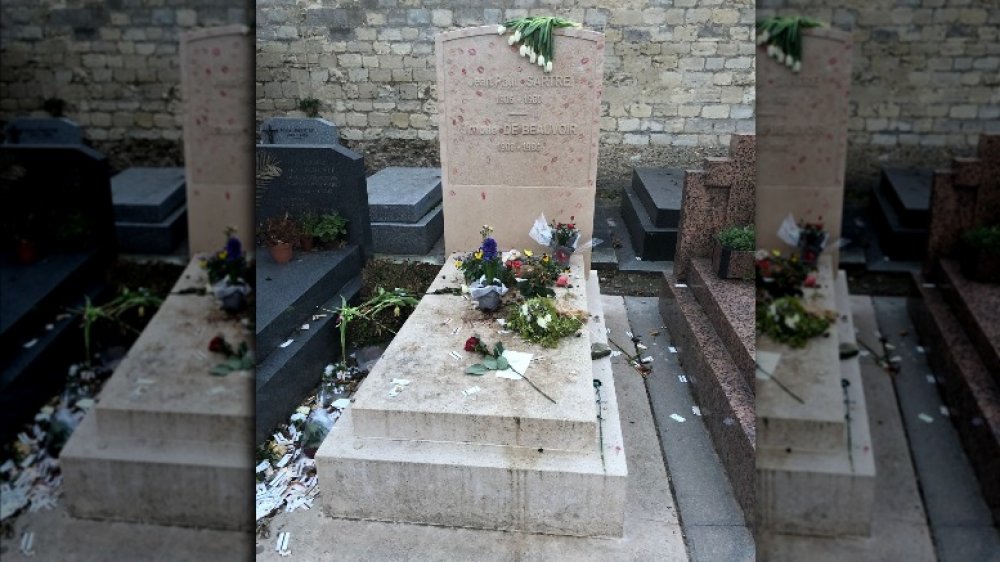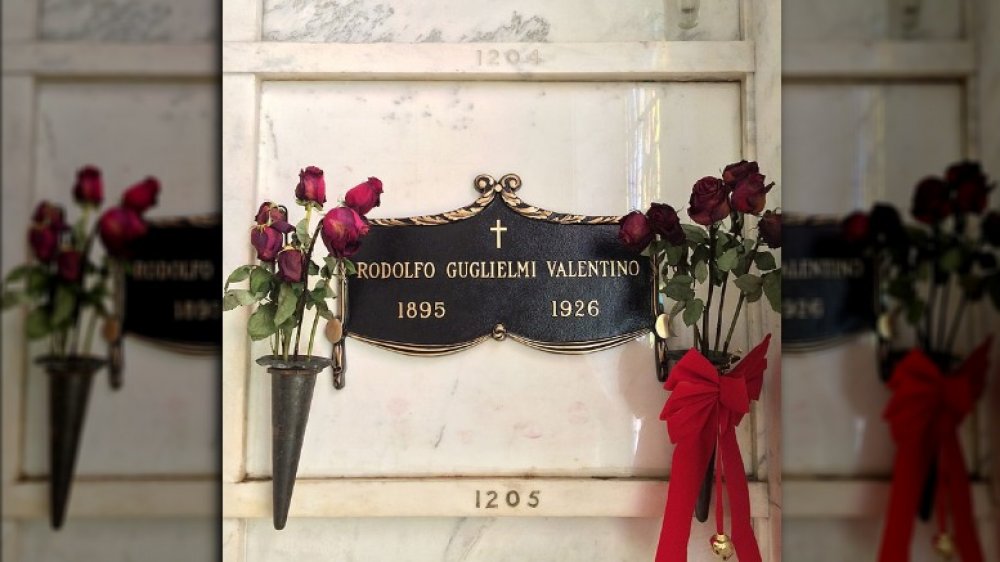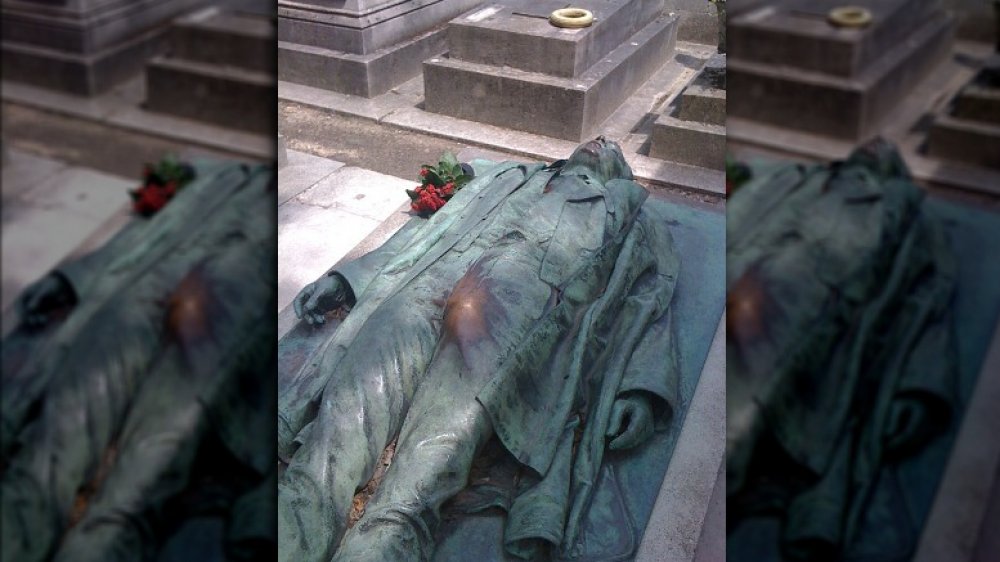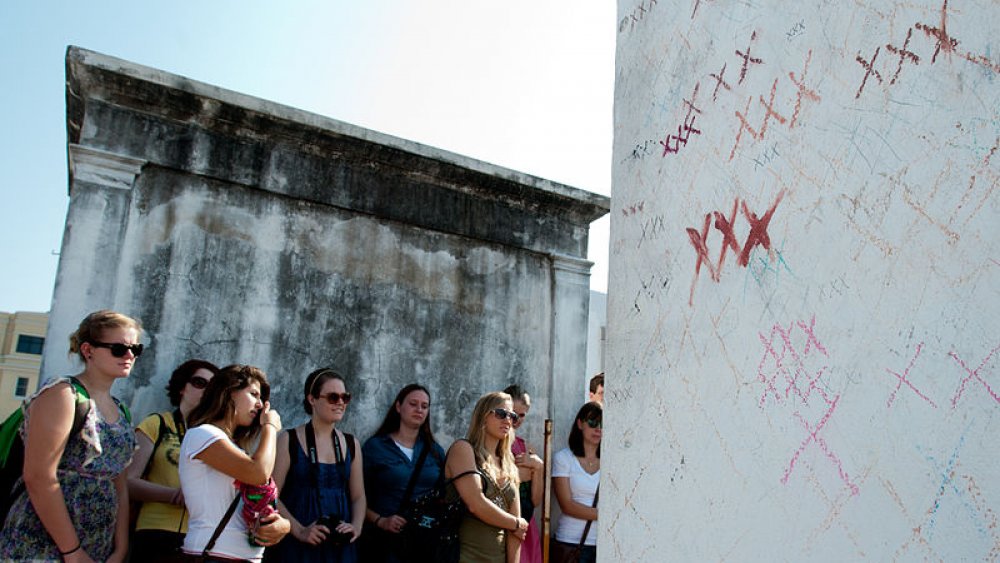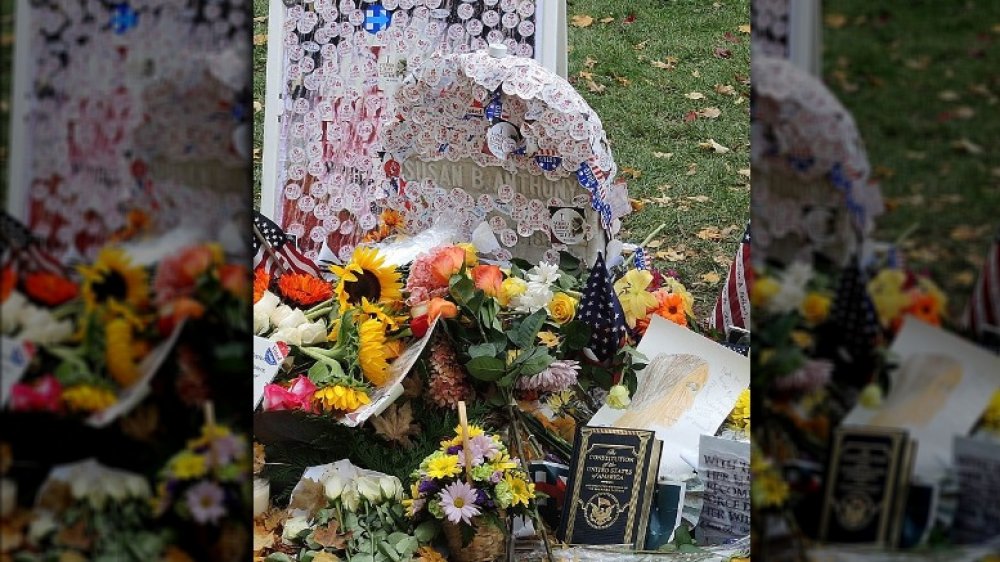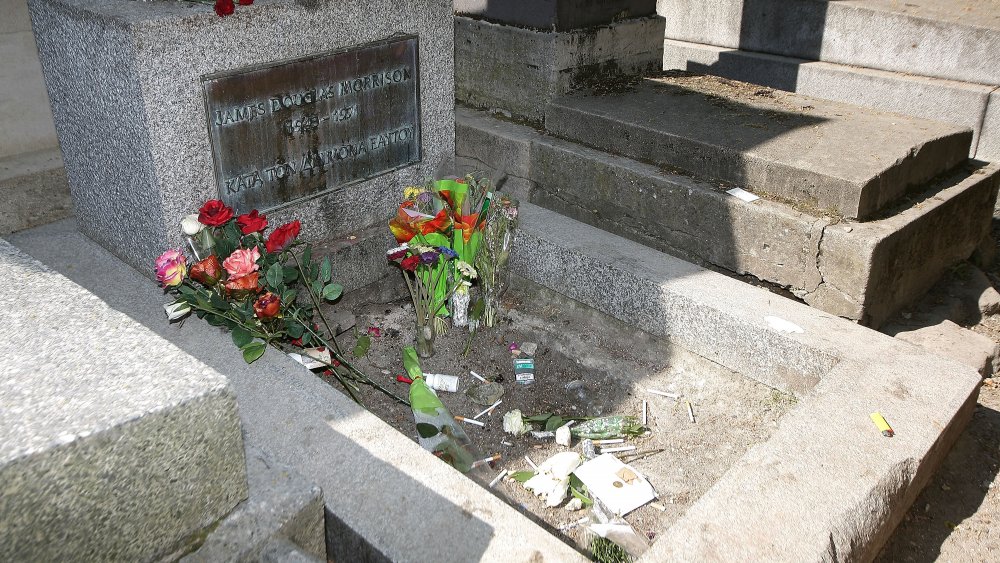Graveside Rituals At Famous Burial Spots Explained
Famous people just can't catch a break. They're mobbed by fans when they are alive, and even going to the extreme length of dying doesn't guarantee them any privacy. The people who stan celebrities still flock to be near them, even when there's six feet of dirt in between the mourner and their idol ... or their idol's bones.
The most fashionable cemeteries out there with lots of famous residents can get millions of visitors a year. But even a small, out-of-the-way graveyard with one lone dead celeb can see dedicated fans make the pilgrimage regularly.
Once they get there, staring at a tombstone might be a bit of a downer for the fan. After all, they traveled all that way to feel a connection to the deceased. That's where graveside rituals come in. They allow people to do something active instead of just reflecting passively; something that's special and specific to their idol's resting place. If someone does an action that has enough meaning, soon others will copy it. And bam, suddenly everyone who shows up is doing it and you have a full-blown graveside ritual.
Harry Houdini's graveside ritual got too popular
Harry Houdini died suddenly, but at least it was on Halloween, the undisputed creepiest day to join the dead. That meant the anniversary of his death was associated with ghosts reaching through the veil to connect with the living. But Houdini never contacted his wife through the yearly seances she did for a decade after he died, per NPR.
He did, however, get one heck of a tombstone. The massive monument (pictured) quickly became home to another yearly ritual on the day of his death. This one included fellow magicians. Starting in 1926, the year Houdini died, and continuing to this day, the Society of American Magicians (SAM) holds a "Broken Wand" ceremony over the grave, according to Atlas Obscura. Originally, this was held on Halloween, but the crowds got so out of control that Wild About Harry says SAM now selects "a secret date in November."
While there's a bit more to it, the ceremony revolves around its titular event: breaking a wand over the grave. It's supposed to symbolize that the wand is useless without the magician. None of the wands were actually Houdini's, but they specially made ones that break easily, since it's just about the symbolism. It's now common to perform a wand breaking at other magician's funerals, but it started at Houdini's grave. He's the only one who has it performed every year. Even almost 100 years after his death, Houdini is the undisputed master of his craft.
Edgar Allan Poe's grave got a mysterious visitor for decades
Edgar Allan Poe was originally buried in a cemetery in Baltimore. While his body was later removed, a large stone effigy to the writer still stands. It's here one of the most iconic graveside rituals started almost 100 years ago.
According to Smithsonian, the first recorded sighting of the Poe Toaster was in 1949, although it's thought he started earlier. Every year, on the anniversary of Edgar Allan Poe's death, a mysterious man would appear at the effigy, pour a glass of cognac, toast the poet, then leave the rest of the bottle and three roses as an offering. Over time, people gathered to watch the yearly ritual. The Poe Toaster always wore the same outfit, and sometimes he would leave notes behind, including one in 1999, saying "the torch has been passed." The second Poe Toaster was more controversial (his notes were sometimes political or sports-related), and by then the media frenzy surrounding his graveside ritual made it hard for him to remain anonymous and sneak in and out unbothered.
Probably getting completely fed up with it and not as into Poe as the first guy had been, the second Poe Toaster performed the mourning ritual for the last time in 2009, so Poe enthusiasts decided to keep it going. An official Poe Toaster III was appointed by the Maryland Historical Society, and the tradition restarted in 2016. Much was kept exactly the same, except now the toaster isn't anonymous.
Fredrick the Great is covered in potatoes
It took the Prussian ruler Fredrick the Great over 200 years to get the simple burial he wanted. For some reason, when you rule a whole country and win lots of wars, your people won't allow you peace next to your dogs at your modest (relatively, anyway) country house. They insist on something grander. But by 1991, the king's remains were finally removed to his selected location, and placed under a flat, plain slab reading simply "Fredrick the Great." (Except in German, obviously.) Since he was laid to rest the final time, visitors can get up close and personal to Fredrick's gravestone, and they leave potatoes on it.
According to HitsoryNet, as weird as it is to think of now, potatoes were seen as exotic and slightly scary to Europeans when they were introduced in the 1500s. After all, they came from the exotic and slightly scary New World. Peasants fed them to their cows and pigs but would never think of eating them themselves. The Russian church even said they must be bad since they weren't in the Bible.
Fredrick was forward-thinking, though. He knew eventually there would be another famine of grains and cereals, and potatoes could replace bread when it was in short supply. He made eating potatoes not only acceptable but cool and probably saved thousands of lives when the famines eventually came. (He even encouraged stealing potatoes from his own fields.) Today, people honor this intelligent decision by leaving potatoes on his humble grave.
Oscar Wilde's tomb had to be protected from his fans
Oscar Wilde had both a privileged and difficult life, eventually ending up doing hard labor in prison for a couple of years, after he lost a court case and was outed as gay. Shortly after being released, he died abroad in France, in near poverty. It took about a decade, but he was eventually buried in the fancy Père-Lachaise Cemetery under a massive gravestone carved to look like an odd hybrid of an angelic/sphinx-like being. Whatever it is, it's naked.
Oscar Wilde's life story is so tragically romantic, it makes sense his fans would want him to feel their love even underneath his tombstone. Maybe love means never having to say you're sorry ... for destroying your loved one's grave. Modern Oscar Wilde fans certainly seem to think so. Unlike in the 1960s, when a vandal knocked off the statue's genitals and stole them, modern-day fans didn't mean to hurt the monument, but they did.
It's not known who first left a lipstick kiss on Wilde's tombstone in the 1990s, but within a short period, the Guardian says it was a "cult pastime" and the thing was completely covered. The problem is, the grease from the lipstick was sinking into the stone. Every time officials had the layer of lipstick kisses cleaned off, it damaged it more. Even Wilde's grandson begged people to stop, but they wouldn't. So in 2011, after one last cleaning, a glass barrier was installed.
Elvis Presley's graveside ritual takes a whole week
Elvis Presley was the undisputed king of rock 'n' roll, so it makes sense that he'd have a graveside ritual fit for an actual king. The yearly ritual at his grave (located on the grounds of Graceland, his famous mansion) lasts a full nine days. It is called, perhaps a bit unoriginally and horologically imperfectly, Elvis Week. According to a Graceland spokesperson, this yearly ritual draws anywhere from 30,000 to 50,000 people from around the world.
The Tennessee tourism board declared 2017's celebration (the 40th anniversary of his death) "the largest Elvis Week ever." It featured concerts, celebrity guests (including Priscilla Presley herself), charity concerts, an auction, an Elvis lookalike contest, and more. But the most important part of Elvis Week is the Candlelight Vigil. Thousands of fans form a procession from Graceland's front gate, up the driveway, to Elvis' grave located in the Meditation Garden, where they spend all night listening to his music, looking at the special memorials fans set up for the occasion, and thinking about how gosh darn awesome Elvis was.
Even the coronavirus pandemic could not ruin 2020's Elvis Week. Instead, the festivities went mainly virtual, although there were some in-person events done as safely as possible, like Graceland hosting drive-in showings of Elvis movies. The candlelight procession and vigil still happened, but fewer tickets were available, and guests wore masks and socially distanced. After all, graveside rituals only mean something if people keep doing them.
Jean-Paul Sartre and Simone de Beauvoir's graveside ritual has unknown origins
The philosopher Jean-Paul Sartre died in 1980 and his love and life partner, the feminist writer and philosopher Simone de Beauvoir followed him to the grave six years later. Literally, in this case, since the pair share a grave in Paris' Montparnasse Cemetery. It's covered by a plain slab and gravestone, only carved with their names and birth and death dates. But it stands out from the graves around it since it's the only one covered in Metro tickets. Since the little cards blow away easily, many are weighed down with little stones.
It's not clear exactly how this odd ritual started. Explanations appear mostly on tourist websites or message boards. The consensus seems to be something about Communism. While Sartre and de Beauvoir never declared themselves to be members of any group, they were pretty obviously left-wing and supported many French political groups they aligned with, especially in the turbulent 1960s. The French Maoists believed in stealing from the rich and giving to the poor, with their most famous example coming during a controversial hike in Metro ticket prices. In response, they stole the tickets and gave them away to the French workers the increase most affected. Sartre supported the group, and when the French Maoist leaders were arrested in 1970, he even took over the newspaper so it could still be in circulation, according to The New York Times. Thus, the philosopher has a tenuous connection to Metro cards.
Rudolph Valentino's grave was constantly visited by a woman in black
Rudolph Valentino was Hollywood's first major heartthrob. Women (and everyone else) adored him, to the point it's rumored some attempted suicide when he died aged just 31 in 1926. And at least a few people couldn't move on, even once Valentino was very, very dead. Various mysterious women in black have visited the movie star's grave on a regular basis for decades.
According to Marjorie Magazine, Valentino was supposed to end up in a massive mausoleum that reflected his importance. Until it was built, his body was stored in a borrowed crypt in the Hollywood Forever Cemetery. The mausoleum never happened, so he's still there. And random women keep showing up to leave flowers.
The identity of the first "Lady in Black" is a mystery, although the Independent reports many have claimed to be her or be related to her. It started with a mysterious veiled woman leaving a rose at Valentino's grave on the anniversary of his death. Sometimes she arrived in a limo, and the press started asking questions. Other women followed suit, and one woman was still laying daisies at his tomb every day in 1992. That woman claimed her mother was the original Lady in Black, although some think she was just an extra hired by the studio. The most likely claim is that of Ditra Flame, who met Valentino as a child and claims to have mourned as his Lady in Black of 30 years.
Victor Noir didn't agree to any of this
The journalist Victor Noir was famous in his own lifetime, but despite being killed by in a fight in 1870 and having 100,000 people attend his funeral, according to Amusing Planet, modern society would probably have completely forgotten him. Fortunately, he got an awesome tombstone. It's a full-size bronze sculpture of Noir, laying down as if he's fallen and at the moment of death. It's remarkably detailed and beautiful. It also has a big ole bulge in the trouser area.
By the 1970s, someone decided to rub said bulge. Obviously, this caught on, because it's hilarious to be sexually inappropriate with the tombstone representation of dead guys. Atlas Obscura says the ritual has a shaky reasoning behind it, namely, it's said that women who rub the trouser snake will become more fertile. Still, plenty of men and women who have no desire to have children touch Noir up as well, so much so that the grave of this nobody is one of the most visited in Paris' Père-Lachaise Cemetery, a place not short on more famous residents.
As if knowing they should apologize for copping a feel, people also started kissing the statue. All the rubbing and kissing has led to his trouser bulge and lips remaining shiny, while the rest of him turned an antique green over time. A fence was erected to stop the destruction in 2004, but it resulted in major protests and was quickly torn down.
Marie Laveau's grave can make your dreams come true
Even voodoo queens probably get a little bored being dead. Surely the notorious Marie Laveau wants to be back on earth, doing what she was best at in life. Many visitors to her mausoleum in the famous St. Louis Cemetery No. 1 in New Orleans believe Laveau is still granting wishes from beyond the grave. You just have to do the right ritual at her mausoleum.
The problem is, no one seems exactly sure what the ritual is. Little Things Travel explains you're supposed to break a piece of stone off another tomb, spin around three times, use the stone to scrape three X's on Laveau's mausoleum, knock on it, and leave some sort of offering. Meanwhile, The Magic of Marie Laveau says you're meant to approach the tomb and offer Laveau compliments, acknowledge her as Voodoo Queen, draw three red X's, knock three times, then go to the St. Louis Cathedral to light a candle. However, everyone agrees if Laveau grants your wish, you should come back and leave her an offering as a thank you. (If you do venture to the cemetery, don't actually scratch on the tomb or leave anything there, as both get you in trouble now.)
Of course, all these people might be bothering some poor spirit that had nothing to do with voodoo and doesn't understand why visitors to her grave keep demanding things from her. It's possible Marie Laveau wasn't interred in that particular mausoleum at all.
Women honor her fight at Susan B. Anthony's grave
Back in the day, American society had a much more binary idea of gender. There were people with lady parts and people with man parts, and everyone knew that the ability to vote was located in the penis. Without one of those, no participating in democracy for you.
Susan B. Anthony was famously not cool with this. So much so that she went to vote in 1872, and somehow managed it despite her lack-of-penis, and was then arrested and fined. She continued to fight for women's suffrage for the rest of her life, but she died 14 years before the 19th Amendment was passed, granting women in the US the right to vote.
So it's particularly gratifying that a new ritual at her grave began in 2016, the first year a woman was a major party's candidate for president. (While the ritual may have started before, this was when it blew up and was widely reported on.) Spectrum News says that up to 10,000 people visited her grave during that election, and many left their "I Voted" sticker on her gravestone until it was completely covered. NPR reported people did it again during the 2018 midterms, and it seems to be a ritual that will continue. But there is serious concern that the glue from the stickers, over time, will damage the small, simple tombstone. The president of the National Susan B. Anthony Museum has requested women honor the suffragist by voting, nothing more.
Jim Morrison's fans raise hell at his grave
While plenty of people wanted to be around Jim Morrison when he was alive, the dead are less fond of him. According to Paris Mojo, the rituals at his grave are so destructive, the bodies in the neighboring tombs were all removed over time. And this isn't some Podunk cemetery the families of these dead people are taking them from: Morrison is buried in Père-Lachaise in Paris, one of the classiest necropolises in the world.
There are no directions to the grave, so fans draw an arrow on other tombs along with the name "Jim," to help other devotees locate the simple tomb. One reason it's so simple is fans steal anything they can, including a bust in 1988. There's more graffiti on and around Morrison's tomb, which To Die For says has to be removed annually. Fans who show up empty-handed often steal flowers or other offerings from random graves and leave them on Morrison's. Then there is the smoking and drinking, which is endemic. Morrison indulged heavily in both, so mourners honor him by standing over his grave, lighting a cigarette or a joint, and swigging from a bottle of booze. (Since it's illegal to drink in the cemetery, this is very rock 'n' roll.) Many then leave the bottles behind.
Most outrageously, on the 20th anniversary of Morrison's death in 1991, a riot broke out at the grave and fans had to be dispersed with tear gas.
